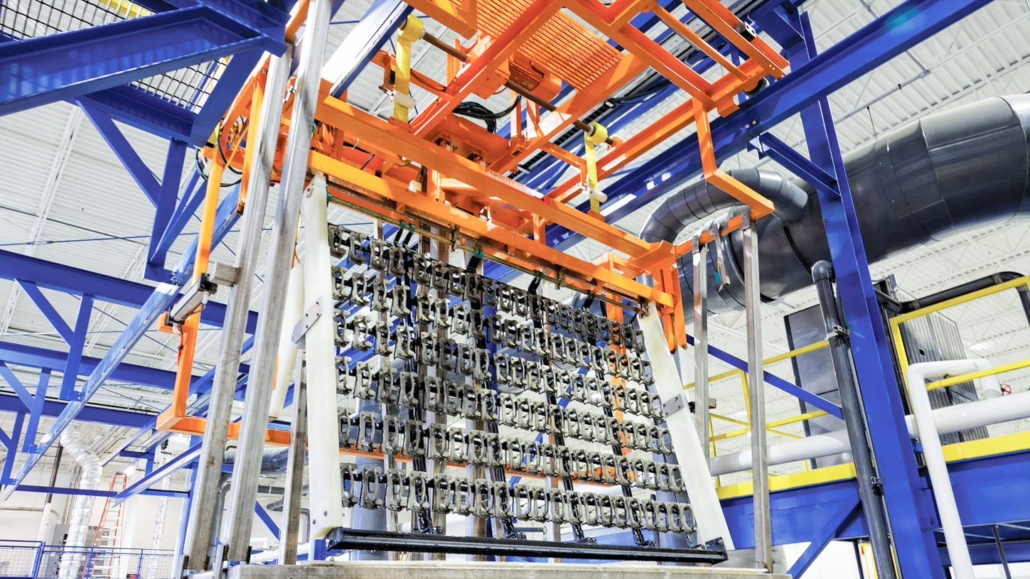English

行业
加入成千上万的行业领导者的行列,与 Chiggo 一起推动产品创新。

解决方案
从原材料到生产和产品增强的一站式解决方案。

资源
您需要了解的有关数字化制造的一切。
对于金属表面处理,阳极氧化通常是第一个想到的方法,尤其是铝。然而,还有一种更通用的替代方法:电镀。与仅限于特定金属的阳极氧化不同,电镀适用于更广泛的材料。通过在零件上沉积一薄层金属,可以显着增强零件的外观、耐腐蚀性、耐用性和导电性。
电镀的历史可以追溯到 19 世纪初,当时意大利化学家 Luigi Brugnatelli 首次使用电流将金镀到银上。然而,直到 1830 年代,英国科学家约翰·赖特 (John Wright) 和乔治·埃尔金顿 (George Elkington) 完善了这项技术,并于 1840 年获得了一种可靠的金属涂层方法专利,电镀才开始广泛工业化。几十年来,它扩展到包括铜、镍和铬等各种金属,使制造商能够保护产品免受腐蚀,同时提高其视觉吸引力。如今,这种复杂的工艺已成为现代制造业不可或缺的一部分。
在本指南中,我们将深入探讨电镀的复杂性,探索其工艺、类型、优点、局限性以及在当今行业成功实施所需的关键因素。

电镀是一种电沉积过程,使用电流将一薄层金属(称为沉积金属)涂覆到另一种材料(称为基材材料)的表面上。通过添加一层所需的金属,我们可以增强基材的美观性和各种性能:导热性和导电性等物理性能、强度和耐磨性等机械性能以及耐腐蚀性等化学性能。
电镀中用作沉积金属的材料是根据其具体性能来选择的,它们可以单独或组合使用,以在基材上达到所需的效果。以下是一些常用的金属:
请注意,必须仔细选择基材和涂层,因为并非所有材料都兼容。例如,钢不能直接镀银;在镀银层之前,必须先镀铜或镀镍。

电镀过程依靠电化学原理在基材上沉积一层薄薄的金属。为了更好地说明这个过程,我们以电镀铜为例。以下是其工作原理的逐步分解:
该过程涉及四个关键部件:阳极、阴极、电解液和电源。正确设置这些组件至关重要:
例如,要在黄铜上涂上铜,黄铜作为基材并连接到负极端子,使其成为阴极。我们使用铜基溶液(例如硫酸铜)作为电解质。该溶液溶解时释放出正铜离子。另一端则采用铜阳极来补充电解液中的铜离子,保证电镀过程中金属离子的持续供应。
一旦阳极和阴极都浸入硫酸铜溶液中并连接到电源,直流电(DC)就会从电源流向阳极。这通过电解质溶液在阳极和阴极之间产生电场。阴极带负电(由于电子过多),而阳极带正电。
在电场的作用下,溶液中带正电的铜离子 (Cu2+) 被吸引到带负电的黄铜阴极。到达阴极后,这些离子获得电子并还原为固体铜,然后以薄铜层的形式沉积在黄铜表面上。
阴极的还原反应为:Cu2+ (aq) + 2e− →Cu(s)
同时,流过阳极的电流导致铜原子失去电子(氧化),以铜离子(Cu2+)的形式溶解到溶液中。
阳极的氧化反应为:Cu(s) → Cu2+ (aq) + 2e−
这些铜离子 (Cu2+) 从阳极迁移到阴极,当铜离子在阴极表面被还原为固体铜时,新的还原循环开始。同时,阳极铜原子失去的电子通过外部电路到达阴极,完成电路。
随着电镀的继续,铜阳极逐渐溶解,不断补充溶液中的铜离子,保持离子浓度稳定。如果使用不同的金属作为阳极,溶液中的铜离子将得不到补充,导致硫酸铜溶液的颜色变浅,浓度降低。

有多种电镀方法可供选择,每种方法都针对不同的应用而定制,并旨在实现特定的结果。以下是主要类型的总结:
| 电镀法 | 特征 | 应用领域 |
| 巴尔埃尔 电镀 | ▪ Small parts are placed in a rotating barrel containing the electrolyte solution. Electrical contact is made to allow plating to occur as the parts tumble. ▪ Highly economical for bulk production; Ensures a uniform coating across all parts. ▪ Not suitable for delicate parts that require high precision; Parts may scratch or entangle due to the tumbling motion. | 用于小型耐用零件,如螺母、螺栓、螺钉和垫圈。 |
| 挂镀 | ▪ Larger or more delicate items are attached to racks, which are then submerged in the plating solution. Electrical current is uniformly distributed through the rack to ensure even plating. ▪ Offers superior coating control, provides a high-quality, consistent finish and minimizes damage to fragile or complex parts. ▪ Capable of coating complex contours, though coverage in deep recesses and narrow grooves may vary depending on current distribution and part design. ▪ More expensive and labor-intensive than barrel plating. | 用于大型、易碎或复杂的零件,例如汽车部件、电气部件、医疗设备、航空航天部件和珠宝。 |
| 连续电镀 | ▪ Involves passing long materials like wires or strips through the electrolyte bath continuously, often referred to as reel-to-reel plating for thin strips. ▪ Highly automated and allows control over coating thickness and consistency. Well-suited for high-speed, high-volume production. ▪ Limited to long, uniform items such as wires and strips; Initial setup can be costly. | 通常用于电子和制造等行业的线材、金属带材和管材的涂层。 |
| 在线电镀 | ▪ Uses an assembly line setup where parts are passed through several stations, each contributing to the plating process. ▪ Automated method minimizes manual labor and controls the use of chemicals more precisely, making it cost-effective. ▪ Provides less control over coating uniformity compared to rack plating; Not ideal for complex geometries. | 通常用于在各种基材上电镀铜、锌、铬和镉等金属,特别是在大批量生产中。 |

通过在基材上涂上一薄层金属,电镀可显着提高物理、机械和化学性能。下面,我们将探讨这些改进的特性并重点介绍典型的行业应用。
电镀使表面更光滑、更有光泽,同时保持低成本,从而改善基材的外观。虽然金属天然具有导电性,但电镀增加了导电性更强的层,可以在不大幅增加成本的情况下提高性能。它还允许非金属用于电气应用,降低成本和重量,从而简化运输和存储。
消费品行业:珠宝和手表经常使用金、银或铑等贵金属电镀来提高其光泽和美观度,从而增加其市场吸引力。家用电器和厨房用品,如餐具、炊具、水龙头和水壶,镀上铬或镍等更闪亮的金属后看起来更有吸引力。电镀还使这些物品更容易清洁。
国防和航空航天工业:黑色化学镀镍可吸收光并减少表面反射。这对于制造需要最大限度降低可探测性的隐形车辆和航空航天部件至关重要。
电子行业:镀金因其强导电性和耐腐蚀性而常用于半导体、连接器和开关。银具有更好的导电性,通常用于需要快速信号传输的电线、触点和 PCB 中。铜具有良好的导电性和较低的成本,可作为黄金的实用替代品,特别是在 PCB 和电气连接领域。
电镀可增强材料的机械性能,根据应用提高拉伸强度、弯曲强度、耐磨性和整体耐用性。此外,它还可以改善表面光洁度,使材料更易于处理并减少摩擦。这些增强功能提高了短期性能,同时也延长了产品的使用寿命。
航空航天和汽车工业:在这些领域,镍和铜镍合金通常镀在飞机机身、结构元件和底盘部件上。该工艺有助于提高整体韧性和弯曲强度。与此同时,镀硬铬广泛应用于发动机零件、轴承和齿轮等关键部件,可提高耐磨性并增强冲击耐久性。
工具和模具制造:镍和钴涂层通常用于强化工具和模具,提高拉伸强度和耐磨性以承受高应力条件。硬铬在这些应用中也很受欢迎,因为它增强了耐磨性,同时最大限度地减少材料粘附。
3D打印和塑料产品:镀镍用于3D打印的SLA树脂和塑料产品,以增强拉伸强度和弯曲性能。这种处理有助于弥合塑料和金属之间的差距,使这些材料的机械性能更接近金属。
电镀形成保护屏障,增强对腐蚀、化学品、紫外线和辐射的抵抗力,延长在恶劣环境中使用的材料的使用寿命。这对于暴露于腐蚀性物质或户外条件下的组件特别有利。
医疗行业:金和钛涂层由于具有高生物相容性和体液耐腐蚀性,常用于心脏支架、关节假体和牙种植体等医疗器械。镀银具有天然的抗菌特性,通常应用于导管和其他装置以降低感染风险。
海洋工业:为了对抗盐水和湿度的腐蚀,镀锌被应用于大型海洋结构,如船舶甲板、栏杆和框架。化学镀镍还用于管道和阀门,在恶劣的海上环境中提供可靠的保护。
化学工业:在化学工业中,设备必须能够承受强酸和强碱。钛涂层因其对这些腐蚀性物质的优异抵抗力而受到青睐,常用于化学反应器、储罐和工业蒸发器,确保即使在极端条件下也能稳定运行。
航空航天工业:航天器和卫星长期暴露在强烈的紫外线和宇宙辐射下,随着时间的推移,材料会降解。为了抵御这些恶劣条件,它们的表面通常镀有铝和金。还使用镀镍,提供额外的耐大气腐蚀能力。
尽管有这些优点,电镀也有其局限性:
电镀涉及使用氰化物、重金属和酸等危险化学品,如果管理不当,可能会导致环境污染。危险废物的处置和废水的处理可能成本高昂,并且必须遵守严格的环境法规以避免污染。
此外,电镀是一种能源密集型工艺,尤其是在大规模生产中,因为它需要持续供应直流电 (DC)。这种高能耗增加了生产成本并导致更大的碳足迹,从而影响环境。
电镀效果依赖于对电流密度、电解质溶液温度和浓度等多个参数的精确控制,以及对预处理过程中每个步骤的严格管理。此外,必须考虑不同基材的特性,因为并非所有材料都与电镀溶液兼容。例如,某些金属可能会在某些溶液中发生电化学腐蚀或不良反应,从而导致涂层无法均匀粘附。
电镀可能是一个缓慢的过程,尤其是在涂覆高质量或厚涂层时。虽然增加电源或电解质浓度可以加快这一过程,但通常会导致涂层不均匀,从而影响整体质量。这种延长的处理时间会延迟生产计划并影响制造效率。
电镀主要适用于薄涂层,通常范围从几微米到几百微米。对于需要更厚、更耐用涂层的应用,热喷涂、熔覆或热浸镀锌等方法更有效。
电镀的好处仅限于表面层。一旦表面涂层被划伤或磨损,下面的材料就会暴露出来,可能会失去电镀所提供的性能增强功能。这使得它不太适合需要深层或结构保护的应用。

电镀是一种强大的技术,可以显着增强材料性能,并已成为各个行业的流行选择。但是,始终如一地执行仍然具有挑战性。这就是为什么与专业电镀供应商合作对于获得可靠结果至关重要。
在 Chiggo,我们的工程师团队经验丰富,在电镀方面拥有十多年的专业知识,使我们成为您项目的理想合作伙伴。拥有先进的制造能力,包括数控加工和钣金制造以及内部设施和强大的网络,我们可以提供高精度金属零件,同时缩短交货时间。 立即联系我们获取专家电镀解决方案!

在加入工程和施工中的材料时,无疑是最广泛使用的两种方法。在金属制造中,这两种技术经常相互称重,以确定哪个是连接定制钣金零件的更好选择。它们之间的决定并不总是直接的,因为必须考虑多个因素,包括材料兼容性,关节强度要求,环境条件以及拆卸或灵活性的需求。

不锈钢只是众多钢种中的一种。它不仅具有强度和韧性,而且还具有优异的耐腐蚀性、良好的机械加工性和焊接特性。它被认为是一种兼具耐用性和成本效益的理想数控加工材料。

在工业应用中,金属的选择不仅受强度,硬度和密度等机械性能的影响,而且还受热特性的影响。要考虑的最关键的热特性之一是金属的熔点。 例如,如果金属融化,炉件,喷气发动机燃料喷嘴和排气系统可能会灾难性地失败。结果可能会堵塞孔或发动机故障。熔点在制造过程中也至关重要,例如冶炼,焊接和铸件,金属需要以液态形式进行。这需要设计旨在承受熔融金属的极热的工具。即使金属在熔点以下的温度下可能会遭受蠕变引起的裂缝,但设计人员在选择合金时通常会使用熔点作为基准。 金属的熔点是什么? 熔点是在大气压下固体开始过渡为液体的最低温度。在这种温度下,固体和液相都在平衡中共存。一旦达到熔点,直到金属完全融化,额外的热量就不会增加温度。这是因为在相变期间提供的热量用于克服融合的潜热。 不同的金属具有不同的熔点,这些熔点取决于它们的原子结构和粘结强度。紧密包装原子布置的金属通常具有较高的熔点。例如,钨在3422°C时具有最高之一。金属键的强度会影响克服原子之间的吸引力并导致金属融化所需的能量。例如,与铁和钨等过渡金属相比,铂和黄金等金属的熔点相对较低,因为它们的粘结力较弱。 如何改变金属的熔点? 金属的熔点通常在正常条件下是稳定的。但是,某些因素可以在特定情况下对其进行修改。一种常见方法是合金 - 将其他元素添加到纯金属上,形成具有不同熔点的新材料。例如,与纯铜相比,将锡与铜混合以产生青铜的熔点。 杂质也可以产生明显的效果。即使是痕量的外国元素也会破坏原子键并转移熔化温度,这取决于物质。 物理形式也很重要。纳米颗粒,薄膜或粉末形式的金属通常在温度较低的情况下融化,因为其高表面积和原子行为改变了它们的散装。 最后,极端压力可以改变原子相互作用的方式,通常通过压缩原子结构来提高熔点。尽管这在日常应用中很少关注,但它成为材料选择和安全性评估的关键考虑因素,例如航空航天,深度钻探和高压物理学研究。 金属和合金熔点图 普通金属和合金的熔点 金属/合金熔点(°C)熔点(°F)铝6601220黄铜(Cu-Zn合金)〜930(组成依赖性)〜1710青铜(Cu-Sn合金)〜913〜1675碳钢1425–15402600–2800铸铁〜1204〜2200铜10841983金子10641947年铁1538年2800带领328622镍14532647银9611762年不锈钢1375–1530(依赖级)2500–2785锡232450钛1670年3038钨〜3400〜6150锌420787 金属熔点的完整列表(高到低) 金属/合金熔点(°C)熔点(°F)钨(W)34006150rhenium(re)31865767osmium(OS)30255477坦塔尔(TA)29805400钼(MO)26204750niobium(NB)24704473虹膜(IR)24464435松(ru)23344233铬(CR)1860年3380钒(V)19103470rh1965年3569钛(TI)1670年3040钴(CO)14952723镍(NI)14532647钯(PD)1555年2831铂(PT)1770年3220thor17503180Hastelloy(合金)1320–13502410–2460inconel(合金)1390–14252540–2600Incoloy(合金)1390–14252540–2600碳钢1371–15402500–2800锻铁1482–15932700–2900不锈钢〜1510〜2750莫内尔(合金)1300–13502370–2460铍(BE)12852345锰(MN)12442271铀(U)11322070杯子1170–12402138–2264延性铁〜1149〜2100铸铁1127–12042060–2200黄金(AU)10641945年铜(CU)10841983银(AG)9611761年红色黄铜990–10251810–1880青铜〜913〜1675黄色黄铜905–9321660–1710金钟黄铜900–9401650–1720硬币银8791614年纯银8931640年锰青铜865–8901590–1630铍铜865–9551587–1750铝青铜600–6551190–1215铝(纯)6601220镁(mg)6501200p pl〜640〜1184锑(SB)6301166镁合金349–649660–1200锌(Zn)420787镉(CD)321610鞭毛(BI)272521巴比特(合金)〜249〜480锡(SN)232450焊料(PB-SN合金)〜215〜419硒(SE)*217423ind157315钠(NA)98208钾(K)63145gall〜30〜86剖记(CS)〜28〜83汞(HG)-39-38 关键要点: 高熔点金属(例如钨,rhenium和tantalum)对于极端热量应用至关重要。这些金属在苛刻的炉子和航空航天环境中保留其结构完整性。钼也可以抵抗熔化,并且对于建造高温熔炉非常有价值。 铁,铜和钢等中等熔点金属将可管理的熔融温度与良好的机械或电气性能结合在一起,使其用于构造,工具和电气系统的多功能。 低熔点金属,例如炮,铯,汞,锡和铅,对于焊料,温度计和低熔合合金等专业应用而言是有价值的。

عربي
عربي
中国大陆
简体中文
United Kingdom
English
France
Français
Deutschland
Deutsch
नहीं
नहीं
日本
日本語
Português
Português
España
Español